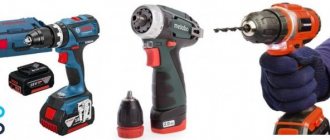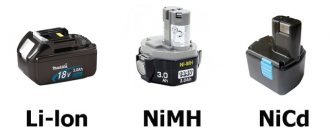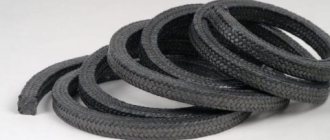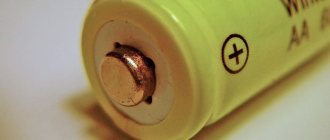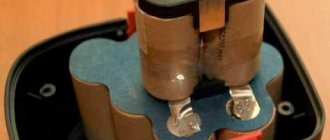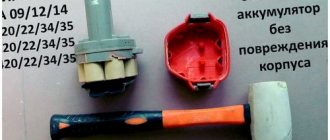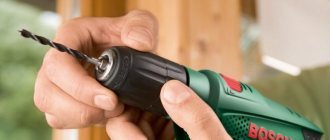Types of batteries for screwdrivers
Before starting repairs, it is necessary to carry out diagnostics, and for this, find out what types of batteries are used in screwdrivers. Such knowledge will help you quickly determine the type of power source and, accordingly, choose the right approach.
Nickel-cadmium batteries
Nickel-cadmium battery is a popular power source for screwdrivers of various powers. Its main advantage is its low price, which is why such batteries are widely used: from hand tools to electric cars carrying large loads. An interesting fact is that even trolleybuses have nickel-cadmium power supplies.
Advantages:
- When used correctly, they have a long service life and a large number of charge/discharge cycles.
- Can remain in storage mode for a long time. It is important to know that nickel-cadmium batteries can only be stored when discharged.
- Low ambient temperature does not affect durability.
- Available according to your own pricing policy.
Flaws:
- If used incorrectly, the self-discharge current increases.
- It is not recommended to open batteries - nickel and cadmium are toxic elements and very harmful to the human body.
You can repair a nickel-cadmium screwdriver battery yourself.
But you will need specialized equipment and some knowledge. It should be immediately clarified that for a one-time repair it is not advisable to purchase special tools and measuring instruments.
Nickel metal hydride batteries
Repairing the battery of a screwdriver with nickel-metal hydride cells is not possible.
It is a fact. But such batteries can be replaced very quickly yourself, but their cost is several times higher than nickel-cadmium power supplies.
Advantages:
- Large capacity. Such power supplies can last 20% longer in one cycle than nickel-cadmium batteries.
- Long service life. With proper handling - at least 300 charge/discharge cycles.
- Does not require complete discharge.
Flaws:
- Nickel-metal hydride power supplies cannot be refurbished, only replaced.
- High pricing policy.
- Insensitive to low ambient temperatures.
The Nickel Metal Hydride cell, which may be very important for some users, is environmentally friendly. But we still shouldn’t forget about the proper disposal of used power supplies.
Lithium-ion batteries
Replacing batteries in a screwdriver, if they are lithium-ion, takes place within a few minutes. But such power supplies, like nickel-metal hydride batteries, cannot be repaired.
Advantages:
- The largest number of charge/discharge cycles among other batteries.
- High capacity.
- Less weight means greater convenience when handling power tools.
Flaws:
- High pricing policy. It is not always relevant to buy a new lithium-ion battery - it is more profitable to purchase a complete power tool.
- If stored incorrectly and without recharging, they quickly become unusable.
Lithium-ion has become the most popular power source for electric cars.
Modern electric vehicles powered by batteries of this type are several times more powerful than gasoline and diesel engines.
Can any battery be repaired?
Interested in how to restore a screwdriver battery, equipment owners forget about the type of batteries built into it. It is useless to revive the ion type - in most cases the issue is related to the decomposition of lithium. Only rarely does the problem occur due to a faulty control circuit.
Specialists restore equipment:
- 18 volts;
- Makita 14.4;
- Metabo, Hitachi, iMax B6, etc.
The process is successful with power: Ni-Cd (NiCd), Ni-MH and Li-Ion.
List of required tools
Repairing or diagnosing a screwdriver battery is impossible without certain tools and measuring instruments. To restore a battery, you don’t have to buy expensive tools; budget manufacturers are quite suitable.
List of tools required to repair the screwdriver battery:
- Multimeter. A measuring device that allows you to determine direct and alternating voltage, resistance, current, or test a circuit for an open circuit. More expensive models are capable of measuring the capacity of elements, but they are not useful to the home craftsman.
- Flat and figured screwdrivers. An indispensable tool that will come in handy more than once in the future.
- Fitter knife with replaceable blades.
- Soldering iron. A power of 40 W will be quite enough. More powerful models are more expensive, and if handled incorrectly, the element can be damaged.
- Tin and solder. Inexpensive consumables.
Consumables will also come in handy, for example, electrical tape or heat-shrink tubing, household glue, and small pieces of wire.
What tools will we need?
When restoring a battery for a screwdriver, you will need:
- screwdriver;
- multimeter;
- tin;
- special flux;
- soldering iron, preferably with a power of at least 100 W.
At the factory, spot welding is used to connect contacts with minimal heat. Therefore, high speed is required when soldering to avoid damaging the battery cell.
Diagnosis of a faulty battery
Before you repair a screwdriver battery at home, you need to find out the cause of its breakdown. Correct diagnosis is 80% of the work done. And this process is not always simple and clear.
Diagnosis of battery faults involves identifying one or more batteries that have failed. The simultaneous breakdown of all batteries is nonsense, occurring once in a century.
Fault detection sequence:
- Fully charge the screwdriver battery pack. A portable power tool is supplied with a special charging socket. In which you need to install the removed battery and give it several hours to fully charge. The end of the charge cycle is indicated by the green indicator on the case lighting up.
Important! The NiCd or NiMH power supply must be completely discharged before charging. Lithium-ion batteries can be charged regardless of the percentage of their capacity.
- Remove the protective battery cover. There are no permanent housings: some manufacturers make bolted fastenings, others use adhesive fastenings. The bolts are easier to deal with - just unscrew them and remove the cover. The glued surface can be carefully cut off with a fitter's knife.
- Carry out a visual inspection. When a battery fails, it usually swells - this is clearly visible to the naked eye. The cause of low capacity may be a burnt wire or jumper between elements.
- Measure the voltage on each bank. Before starting measurements, the multimeter should be turned on to the “Constant Voltage” mode and touch the leads of each element with the probes. There is no need to solder each element.
- Using small cross-section wires, connect a simple 12 V or 24 V car lamp to the screwdriver power source (depending on the rated voltage of the screwdriver battery). Leave the lamp on for 30-40 seconds.
- Disconnect the car lamp from the battery and re-measure the potential difference of each element.
- Determine the element with the maximum drop in capacity and replace it.
- Reassemble the battery in reverse order.
Repairing or diagnosing batteries for a screwdriver can be done with your own hands without much difficulty. This is clearly seen from the above sequence. You just need to have a tool, a minimum amount of knowledge, free time and the desire to do something with your own hands.
The battery on the screwdriver runs out quickly
The problem with rapid self-discharge of the battery is quite common. It consists of fast charging, which occurs in about 20 minutes and the same short operation.
This situation may result from malfunction of the temperature sensor located in the removable battery. This temperature sensor may not be installed this way initially. It must be returned to the place of purchase.
If the battery begins to discharge quickly after prolonged uninterrupted use, which could happen after a fall, you need to get it repaired.
Remanufacturing of Nickel-Cadmium Batteries
Repairing a screwdriver battery can be considered budget-friendly only when the batteries are not thrown away, but restored. To restore nickel-cadmium batteries, you should know the specifics of their operation. For example, when the electrolyte dries out, the only way for such batteries is to a recycling point.
How to restore a nickel-cadmium battery yourself:
- Disassemble the battery, unsolder and charge each jar. In a common battery, it will not be possible to charge all the elements normally - certain current losses will still be present.
- Apply a voltage of 3.6 V to each jar for no more than 3-5 seconds. To do this, you can use regulated power sources: laboratory transformers or car chargers.
- Measure the voltage at the terminals of each bank. If all elements show a voltage of 1.2-1.4 V, this means that the “reflashing” of the nickel-cadmium batteries was successful. If the voltage is low or absent, the battery is damaged or lacks electrolyte.
If after several cycles the nickel-cadmium battery does not want to charge, then the only option is to replace it. It will still be cheaper than buying a new battery.
How does a screwdriver work?
Everything is quite simple here. The simplest screwdriver consists of a plastic case, a battery (1), a speed controller (2), a plastic button (3), a motor (4), a gearbox (5) and a chuck (6).
In modern ones, a gearbox with a planetary transmission of rotational force is most often used.
Restoration with distilled water - fact or fiction?
Many craftsmen who are capable of restoring power tools claim that dried-out power sources cannot be “reincarnated.” Others say that it is possible to restore batteries; all you need is distilled water, a tool and 30-40 minutes of free time.
The sequence for restoring batteries with distilled water is:
- Using a thin bit and drill, make a small hole in the top of the battery can. If you drill into the middle of the element or the bottom, you can damage the power source. It will be impossible to restore it later.
- Using a syringe, fill the battery with distilled water to the maximum.
- Leave the battery in a clean and warm place for 1-2 days, do not cover the hole.
- Connect the cells filled with distilled water into one battery.
- Place the battery on charge until capacity is fully restored. After charging, check the voltage on each jar and, if necessary, add distilled water.
- After checking, close the holes with a glue gun. It is strictly forbidden to solder the holes - this can damage the battery cell.
- Place the battery back into the case, close the lid and recharge.
The home method with electrolyte works, but not always. Sometimes the internal structure of the battery is so damaged that even distilled water does not give a positive result.
Features of operation
During continuous use of Ni-Cd batteries, the discharge capacity and voltage gradually decrease. There are main reasons that explain these processes:
- reduction of active mass and its subsequent distribution among electrolytes;
- thinning of the main surface of negative and positive electrolytes;
- change in the size and consistency of the electrolyte;
- processes due to which loss of oxygen and water begins to occur;
- the appearance of voltage leaks due to the appearance of dendrites in Cd.
These processes are also observed if Ni-MH batteries are used. The only difference is in the electrolyte material used.
During battery operation, due to the distribution of the active mass among the electrolytes, the size of the positive nickel electrolyte and mechanical strength begin to change. As a result, contact with the active mass is reduced.
All these processes reduce capacitance and impair conductivity. In some cases, the contact between the negative and positive electrolytes breaks. As a result, the battery simply no longer shows any signs of life.
Simple restoration: replacement of several elements
If operations with distilled water and “reflashing” nickel-cadmium batteries require time and skill, then to replace used elements you only need a multimeter, a soldering iron and new battery banks.
Before replacing, it is necessary to diagnose the battery and how to do this is correctly described above. The battery consists of individual elements that need to be desoldered. Low-power soldering irons are used for soldering, otherwise the high temperature can damage the power supplies. Low voltage items should be set aside or labeled.
Advice! If possible, it is better to use a soldering station with power adjustment or spot welding.
After identifying faulty power supplies, they simply need to be replaced with new ones, which are re-soldered into a common battery. The cost of individual cans is much lower than the entire assembly, so the savings will be obvious. After all the elements are assembled into the battery, it is necessary to carry out several charge/discharge cycles of the battery.
Common faults
A short circuit is one of the most common faults.
Owners of screwdrivers who decide to repair the battery themselves should familiarize themselves with the most common types of faults. There are several reasons why batteries stop functioning normally:
- destruction of plates;
- short circuit;
- electrolyte contamination;
- reversal of poles;
- degradation of crystals due to long-term storage in a discharged state.
Additional Information! It is quite difficult to cope with the consequences of such breakdowns on your own. This is why many people decide to entrust battery repair to professionals.
Complete replacement and erasing of battery “memory”
In rare cases, for example, if the battery is too old, then all the elements fail. Buying a new battery will still be more expensive than replacing all the batteries. Therefore, it makes sense to order separate power supplies via the Internet, solder them into the battery, and then place them in the old case.
There is a little secret to extending the life of new power supplies. To do this, you need to remove the factory settings from the cans, which are set by several charge/discharge cycles. The operation to extend the lifespan should be carried out only on new elements, and in the future they should be charged correctly.
A new battery bank is discharged to a voltage of 1 V. It is important to monitor this parameter, since below one volt the battery may become unusable, after which it will be impossible to restore it. For discharge, it is best to use an adjustable load, on which the current is set to 1 A.
After complete discharge, all cells must be recharged using the rated current and voltage. After a full charge, you can solder the power supplies into the battery and install them on a screwdriver.
How to identify battery problems
If, when working with a screwdriver, the operating time on a single charge is significantly reduced and the power of the tool drops noticeably, the battery is faulty. You can check this by simply replacing the battery.
Of course, batteries do not last forever, and their service life is limited. The easiest option, of course, would be to buy a new battery. Or you can take a chance and restore the screwdriver battery yourself. To do this, you need to open the battery case, remove the battery and, after identifying the faulty element, replace the latter.
Self-conversion of the battery for lithium-ion banks
A lithium power supply has many advantages:
- Less weight.
- Reduced charging time.
- Absence .
Therefore, some craftsmen are trying to purchase an inexpensive screwdriver with a nickel-cadmium battery and convert it to lithium batteries. It is immediately necessary to clarify that lithium-ion batteries are much more expensive than all other power sources and their disadvantages.
Rework process:
- Calculate the required number of lithium cans for the battery. You can select more power and thus reduce the number of elements.
- Using jumpers, connect all batteries into a single battery.
- Solder the battery to the controller board, designed for the operating current of the screwdriver.
- Disassemble the screwdriver battery and remove all nickel-cadmium batteries.
- Solder together the output contacts of the controller board and the terminals of the battery case. Completely assemble the body.
Please remember that after replacing power supplies, a new charger may be required. Otherwise, the power of the old one simply will not be enough to restore the full capacity of the battery.
Checking the battery after repair
After replacing battery elements, it is necessary to equalize the potentials of all battery elements. To do this, leave the latter to charge for a long time. Then, after charging the battery of the screwdriver, you need to leave it for about a day to recover.
You can discharge the battery by using a screwdriver until it is completely discharged or by connecting a load to it. For example, an incandescent lamp designed for the appropriate voltage. To equalize the battery charge, the charge and discharge cycle should be repeated twice.
Reasons for complete discharge
All the described processes in the Ni-Cd electrode occur due to regular recharging, during which oxygen is formed on the surface of the electrolyte. The more often the discharge-charge procedure occurs, the more compaction of the crystals of the electrolyte mass is observed. Therefore, the working surface is reduced, and, accordingly, the battery capacity is reduced.
On a cadmium electrolyte, the deformation procedure occurs, as a rule, due to the redistribution of the active mass. As a result, its definite loss begins. In addition, the mass clogs the porous surface of the negative electrolyte. Because of this, access of the electrolyte to the deep layers is complicated. The consequence of the migration of the active mass is an increase in the volume of dendritic bridges through the separator to the electrolyte, this leads to multiple short circuits and increases the discharge time. On a cadmium electrolyte during operation, the active mass also increases and the crystals become denser. We recommend: Operation of Ni-Cd batteries
In addition to the processes described above, batteries undergo oxidation of various impurities that are inside. The cermet of the positive electrolyte oxidizes over time due to water consumption.
Another negative point that leads to a decrease in the performance of the battery is the selection of the electrode from the separator. This begins to happen due to changes in the surface of the electrolyte and leads to an increase in resistance.
The composition of the electrode also changes over time. This includes an increase in the volume of crystals. Electrical conductivity decreases and all battery performance deteriorates during discharge. This process is especially noticeable at low temperatures.

